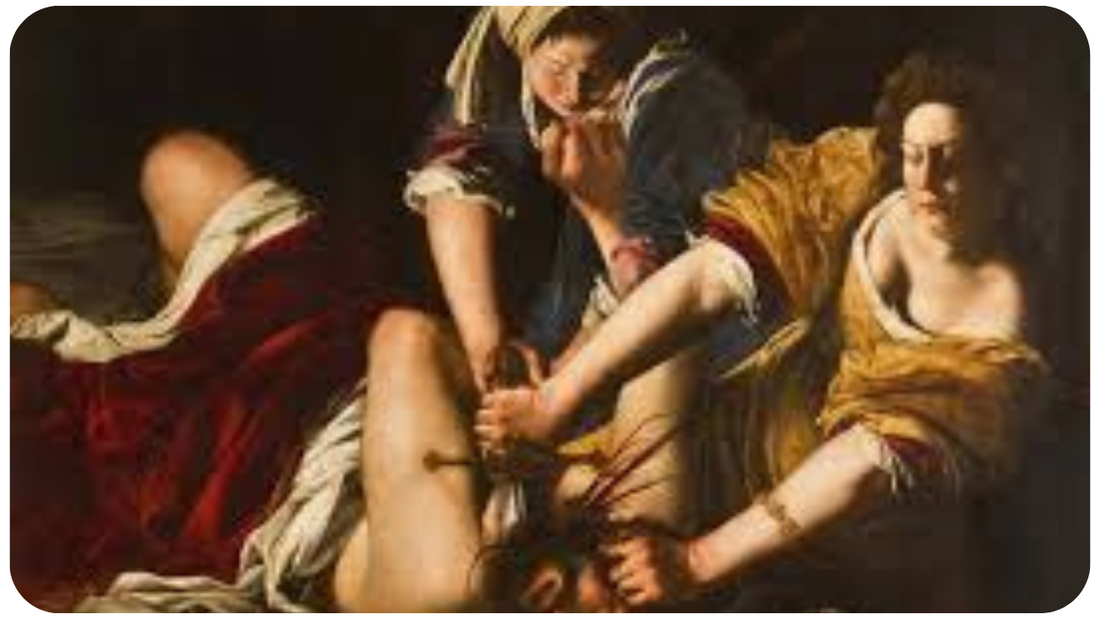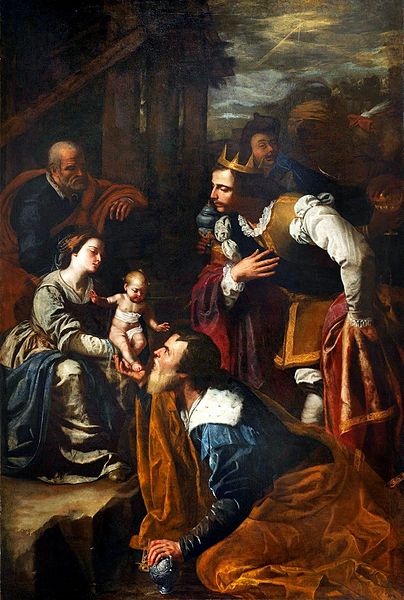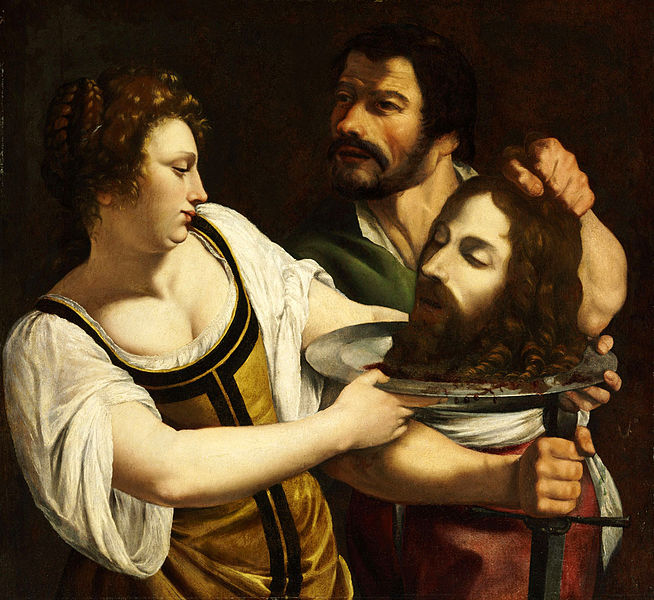Artemisia Gentileschi (Rome, July 8, 1593 - Naples, 1656) was an Italian Baroque painter, considered today one of the most successful painters of her time. Being encouraged in painting from her childhood by her father Orazio Gentileschi, who was a famous painter from the town of Pision, she became the first woman to be a member of the Florence painting academy.
Many of her subjects are female characters who appear in various passages in the Bible, but her fame as a painter began with portrait painting. When her father was invited to paint at the court of King Charles I of England, Artemisia accompanied him, and at this time she was invited to paint several portraits of English court nobles.
Among her best known paintings are Judith Beheading Holofernes and Susanna and the Elders. Her art was overshadowed by the rape she suffered in the 17th century, but fortunately what shines out to the world today is her enormous talent.
Artemisia Gentileschi's Biography
Personal life and beginnings
Born Artemisia Gentileschi-Lomi on July 8, 1593, in Rome, her baptismal certificate in the Archivio di Stato indicated that she would have been born in 1590, the eldest daughter of the Tuscan painter Orazio Gentileschi and Prudentia Montone. Artemisia was introduced to painting in her father's studio, showing herself to be much more talented than her brothers, who worked alongside her.
She soon learned to draw, to mix colors and then to paint, inspired by her father's style, quite centered on that of Caravaggio. However, the way Artemisia worked with subjects was different from her father. His paintings were extremely natural, while his father idealized what he portrayed.
At the same time, Artemisia resisted submitting, both in attitude and psychologically, to the idealizing style of painting. This is how her works began to gain admirers and recognition.
At the age of 17, she produced Susana and the Elders. Due to the habit of the time that it was common for a painting done in partnership to be attributed to the best known painter, many believed that she had her father's help in conceiving the work, which shows how Artemisia absorbed Caravaggio's realism, without discarding the language of the Bologna School, which had Annibale Carracci among its prominent artists.
It is one of the paintings on the subject of Susana showing the sexual approach of the two elders as a traumatic event.
In 1611, his father was working with Agostino Tassi to decorate the vaults of the Casino delle Muse, inside the Palazzo Pallavicini-Rospigliosi in Rome. Tassi hired him to teach Artemisia privately and while teaching her, he raped her, with Cosimo Quorli as his accomplice.
Artemisia had to continue to have a relationship with Tassi, hoping that a marriage to him would restore her reputation in society, but he went back on his promise to marry her. Nine months after the alleged rape, when he learned that Tassi would not marry Artemisia, Orazio filed a complaint against him. Orazio also alleged that Tassi stole the painting Judith beheading Holofernes from his property.
The main issue in the trial was related to Artemisia's virginity. If she was not a virgin before the rape, her family had no right to press charges. During the seven-month trial, Tassi was accused of planning the murder of his wife (which was not proven) and of having an extramarital involvement with his sister-in-law, something that was considered an incest crime at the time due to her relation to Tassi's ex-wife, as well as being accused of planning to steal some of Orazio's paintings.
Artemisia underwent a gynecological examination by two experienced obstetricians, and the ordeal of the Sibyls during the trial to attest to the veracity of her testimony. In the end, Tassi was sentenced to prison for a year, but he never served his sentence, as the case was reviewed and his sentence overturned. What he went through at the trial ended up inspiring Artemisia's feminist views, which influenced her art.
Having lost her mother when she was only 12 years old, Artemisia lived surrounded by the male presence of her parents and brothers. At the age of 17, Orazio rented the apartment above his house to a woman named Tuzia, with whom Artemisia soon became friends.
However, Tuzia allowed Agostino Tassi and Cosimo Quorlis to accompany Artemisia on several occasions. When the rape happened, Artemisia screamed to Tuzia for help, who ignored her screams and then pretended that nothing had happened. The painting Mother and Child, now in the Spada Gallery in Rome, is from that time.
A month after the trial, Orazio arranged a marriage for his daughter to Pierantonio Stiattesi, a little-known artist from Florence, and shortly after her move to the city, she received a commission from the Casa Buonarroti. Artemisia became a well-known painter at court, with patrons such as the House of Medici and Charles I of England. In Florence, Artemisia and Pierantonio had a daughter, Prudentia, in 1618. Prudentia is believed to have followed in her mother's footsteps, but no work of hers is known.
Florentine Period (1614-20)
Artemisia experienced a moment of great success while living in Florence. She was the first woman accepted into the Florence Academy of Fine Arts. She had good relationships with the great artists of the time, such as Cristofano Allori, gaining the respect and favor of many influential people in society, such as Cosimo II de Medici, grand duke of Tuscany and the grand duchess Cristina of Lorraine.
Artemisia also had contact with Galileo Galilei, as a letter to the scientist in 1635 suggests. She was also greatly admired by Michelangelo's nephew, as he invited her to contribute to the painting of the ceiling of the Buonarroti House, whose work was large and extensive.
In 2011, 36 letters were discovered, dating from 1616 to 1620, which gives new insight into Artemisia's personal and financial life in Florence. One of the surprises was the revelation of her affair with a nobleman named Francesco Maria Maringhi and the fact that her husband had no problem with the extra-marital relationship.
Her husband probably tolerated the relationship because he knew that Francesco's support was necessary to support the family. However, in 1620, rumors of the love affair began to spread around the court and, coupled with the family's financial and legal problems, Artemisia was forced to return to Rome in 1621 without her husband.
Neapolitan and English period (1630-1654)
In 1630, Artemisia moved to Naples, a city known to art admirers for its workshops, in an attempt to find more lucrative work opportunities. Several artists such as Caravaggio, Annibale Carracci and Simon Vouet lived in the city for a time.
At the time, Jusepe de Ribera, Massimo Stanzione and Domenichino were working in Naples, and then Giovanni Lanfranco and many others began to arrive. Artemisia's debut in the Neapolitan art community was with her painting Annunciation. She remained in Naples until the end of her career, with the exception of a few trips to England.
Naples would become her second home and it was there that her daughter married. On a Saturday, March 18, 1634, a traveler named Bullen Reymes recorded in his diary a visit to Artemisia and her daughter with a group of English friends. Artemisia received letters from various nobles and patrons throughout Europe, and had good relationships with several renowned artists.
In 1638, she joined her father at the court of King Charles I in London, where Orazio had become an official painter and received an important job decorating the ceiling of the Queen's House, Henrietta Maria of France, in Greenwich. Father and daughter then worked together once more, but her father's invitation was not the only reason for Artemisia to be in London.
The king invited her to his court, and this was not a request to be refused. Charles I was a great and keen collector of art, squandering the coffers of the kingdom to increase his collection. Artemisia's fame probably intrigued him, and one of his main paintings was a self-portrait of Artemisia called Self-Portrait as an Allegory of Painting.
Orazio died suddenly in 1639. It is known that Artemisia had left England in 1642 when the English Civil War broke out. Little is known about her life in this period. It is known that by 1649 she was back in Naples, corresponding with Don Antonio Ruffo of Sicily, who would become her mentor during the second Neapolitan period. Her work, as she grew older, was taken over by strong women taken from various biblical legends.
Style of Artemisia Gentileschi
Artemisia is considered a Baroque artist with strong influences from Caravagism. In her works, it is possible to identify characteristics of Caravaggio's style such as realism and the dramatic use of chiaroscuro, a painting technique characterized by the play of contrasts established by the use of light and dark colors.
She is also recognized for, during the Renaissance, performing a self-portrait in which she represented herself as the allegory of Painting, something that male painters could not do, since this figure was always represented by a woman. In Self-Portrait as Allegory of Painting, Artemisia represents herself next to paints and carrying a brush, while effectively employing the act of painting.
Death of Artemisia Gentileschi
Artemisia was believed to have died between 1652 and 1653, but recent evidence shows that she was still accepting commissions in 1654, but heavily dependent on the help of her assistant, Onofrio Palumbo. It is speculated that she died in the devastating plague that swept Naples in 1656 and that consequently wiped out a whole generation of great artists.
Feminist interest
Feminist interest in Artemisia Gentileschi was sparked in the 1970s, when feminist art historian Linda Nochlin published an article entitled "Why Have There Been No Great Women Artists?" in which this question was dissected and analyzed.
The article explored the definition of "great artists" and postulated that oppressive institutions, not lack of talent, prevented women from achieving the same level of recognition that men received in art and other fields. Nochlin said that the studies on Artemisia and other female artists were "worth the effort" in "adding to our knowledge of women's achievement and art history in general."
According to Douglas Druick's foreword in "Violence & Virtue: Artemisia's Judith Slaying Holofernes by Eve Straussman-Pflanzer, Nochlin's article led scholars to make more of an attempt to "integrate women artists into the history of art and culture."
Artemisia and her work became a focus again, having had little attention in art history studies except for Roberto Longhi's article "Gentileschi padre e figlia (Gentileschi, father and daughter)" in 1916 and R. Ward Bissell's article "Artemisia Gentileschi-A New Documented Chronology" in 1968.
As Artemisia and her work began to attract new attention among feminists and art historians, more literature about her, fictional and biographical, was published. A fictional account of her life by Anna Banti, wife of critic Roberto Longhi, was published in 1947. This account was well received by literary critics, but criticized by feminists, notably Laura Benedetti, for being indulgent in historical accuracy in order to draw parallels between author and artist.
The first full, factual account of Artemisia's life, The Image of the Female Hero in Italian Baroque Art, was published in 1989 by Mary Garrard, a feminist art historian. She then published a second, smaller book entitled Artemisia Gentileschi around 1622:
The Shaping and Reshaping of an Artistic Identity in 2001, which explored the artist's work and identity. Garrard noted that the analysis of Artemisia's work lacks focus and stable categorization outside of the category "woman," although Garrard questions whether femininity is a legitimate category for judging her art.
Artemisia is known for her portraits of subjects from the Women's Power (Weibermacht) group, for example, her versions of Judith Beheading Holofernes. She is also known for the rape trial in which she was involved, which scholar Griselda Pollock has argued has unfortunately become the repeated "axis of interpretation of the artist's work."
Gentileschi's status in popular culture, although she is greatly admired among art historians, is considered by Pollock to be less due to her work and more to the sensationalism caused by the persistent focus on the rape trial during which she was tortured. Pollock offers a counter-reading of the artist's dramatic narrative paintings, refusing to see the images of Judith and Holofernes as responses to the rape and the trial.
Instead, Pollock emphasizes that the subject of Judith and Holofernes is not one of revenge, but a story of political courage and indeed collaboration of two women who committed a daring political murder in a war situation.
Pollock seeks to shift attention away from sensationalism to a deeper analysis of Gentileschi's paintings, notably of death and loss, suggesting the significance of her childhood mourning as the source of her unique images of the dying Cleopatra.
Pollock also argues that Gentileschi's success in the 17th century depended on her producing paintings for clients, often depicting selected subjects. She intends to place Gentileschi's career in its historical context of her fondness for dramatic narratives of heroines from the Bible or classical sources.
On a more negative note, American professor Camille Paglia has argued that the modern feminist concern with Artemisia is misplaced and that her accomplishments were exaggerated: "Artemisia Gentileschi was simply a polished and competent painter in a baroque style created by men."
Feminist literature tends to revolve around the event of Artemisia's rape, portraying her largely as a traumatized but noble survivor whose work became characterized by sex and violence as a result of her experience. Pollock (2006) interpreted Agnes Merlet's film as a typical example of popular culture's inability to look at the painter's remarkable career over many decades and in many major art centers, rather than at this single episode.
A literature review by Laura Benedetti, "Reconstructing Artemisia: Twentieth Century Images of a Woman Artist," concluded that Artemisia's work is often interpreted according to contemporary issues and the authors' personal biases. Feminist scholars, for example, have elevated Artemisia to the status of a feminist icon, which Benedetti attributed to Artemisia's paintings of formidable women and her success as an artist in a male-dominated field, while at the same time being a single mother.
Artemisia Gentileschi's Gallery
Adoration of the Magi, circa 1636 to 1637. Oil on canvas, 311 × 206 cm. Cathedral in Pozzuoli, Naples
Lot and his daughters, ca. 1635 and 1638. Oil on canvas, 230.5 × 183 cm. Toledo Museum of Art
Christ and the Samaritan woman at the well, before 1637. Oil on canvas, 267.5 × 206 cm. Private collection, Naples
Cleopatra, circa 1620. Oil on canvas, 97 × 71.5 cm. Private collection.
Christ Blessing the Children, circa 1624-1625. Oil on canvas, 134.6 × 97.7 cm.
Penitent Magdalene, 1615-1616 or 1631. Oil on canvas, 65.7 × 50.8 cm. Private collection
Saint Catherine of Alexandria, circa 1635. Oil on canvas, 76 × 67 cm. Private collection
Salome with the head of St. John the Baptist, 1610-1615. Oil on canvas, 84 × 92 cm. Budapest Museum of Fine Arts
David and Bathsheba, circa 1636 to 1637. Oil on canvas, 265.43 × 209.55 cm. Columbus Museum of Art
The Virgin nursing the child, ca. 1616-1618. Oil on canvas, 118 × 86 cm. Private collection










